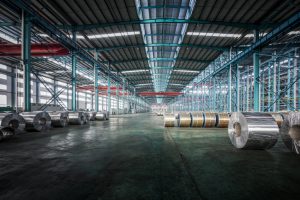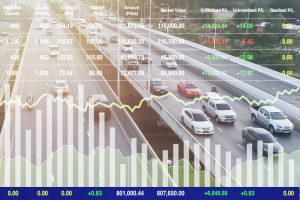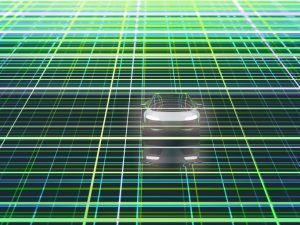The COVID-19 pandemic has brought us face to face with major changes in our lifestyles. Visits to offices have decreased dramatically as people engage in telework from home. We avoid direct person-to-person contact and hold meetings online, in companies and schools alike. Digital transformation (DX) supports these changes – and is bringing great changes to the automobile as well. It is often remarked that, seen from outside, the characteristics of DX are difficult to fully understand. The same holds true in the case of automobiles. The presence of DX does not mean that “DX” is inscribed in the automobile’s badge, but dramatic changes are taking place inside.
The evolution of E/E architecture
1. The challenges facing conventional E/E architecture:
Conventionally, a number of in-vehicle electric and electronic devices have been mounted in automobiles. About 50 engine control units (ECUs) in ordinary automobiles and over 100 in luxury automobiles make use of sensors and actuators to operate engine controls, lights, windows, navigation systems, and more. The large control system that connects these ECUs, sensors, architecture, and so on to compose the automobile is called the E/E (electric/electronic) architecture. This E/E architecture is now set to undergo a great evolution. The E/E architecture used in today’s cars is known as a functionally distributed architecture. As the name suggests, this is a structure that deploys ECUs optimized for each function, such as engine control, brake control, and mirror control, and is a form that came about as control systems were added to meet the increasing functionality of automobiles. As the resulting functionally distributed architecture structure is extremely complicated, and as independent software is installed in hardware ECUs on a per-function basis, the functional linkages and cooperative control needed to realize driver Advanced Driver Assistance Systems (ADAS) required coordination among related control systems, placing pressure on OEM development man-hours. The software embedded in the ECUs of an automobile totals 100 million lines of code, a scale that greatly exceeds that of the software in the F-35 fighter jet (24 million lines) or Microsoft Office 2013 (44 million lines). It is said that the scale of this software will exceed 600 million lines of code by 2025 as automobiles undergo dramatic evolution through the progress of CASE. In short, if the situation continues as it is now, it will sooner or later become unmanageable.
2. Domain intensive:
To cope with the increasing complexity of control as CASE evolves, automobile OEMs are now engaged in urgent development of “domain-intensive architecture” instead of the functionally distributed architecture that has been used up to now. This architecture is structured in a way that bundles ECUs for each area of application/function (“domain”), such as safety and powertrain control, body control, or radar/vision control, and deploys a domain controller that conducts communication and coordination control among the ECUs. Updating of automobiles has not been carried out via wireless communication (“over the air,” or OTA) as done with smartphones (with the exception of some specific functions such as mapping information for navigation). The evolution of E/E architecture to become domain-intensive, however, will make updating automobile software possible. This is because domain-intensive architecture is organized more simply than conventional architecture, the flow of data is clearer, and the location of the software to be updated is centralized to an extent, facilitating both update delivery and cybersecurity measures. In addition, the proliferation of 5G telecommunications will provide support for OTA.
3. Centralized:
E/E architecture will continue to evolve as automobiles functions become more sophisticated to support Level 4 autonomous driving (fully autonomous driving under specific conditions). It is thought that by 2025, the above architecture will go beyond domain-intensive and will further consolidate into centralized architecture. Under this architecture, the current 50 to 100 ECUs in a vehicle will be replaced by about 3 high-performance central computers. Software embedded in individual distributed ECUs will be centralized and simplified in the central computers, facilitating updating. Continuous software updating and upgrading of software will become easier to achieve.
Impacts of the evolution of E/E architecture
1. Tesla lights the fuse
Industry newcomer Tesla has been at the forefront of the above changes. Since its entry into the automotive industry, the company has employed centralized electronics boards for all of its models. By contrast, the distributed architecture long used by conventional automobile OEMs is the outcome of a course that emerged as ECUs increased in line with the functional evolution of vehicles, not the result of some overarching concept. Aside from need for functional coordination/cooperative control, the difference between the two in performance is clear. The OTA perspective, too, is as already noted. Once consolidated, ECU hardware and software will both become more economical, with no need to distribute areas shared in common.
2. Impacts on industrial structure:
Conventional automobile OEMs purchased components (function-specific modules) provided by suppliers as sets of hardware and software. The result of this has been decentralized architecture. With the organization and integration of these, and with shift from domain-intensive to centralized architecture, however, it will no longer be necessary to purchase hardware and software as a set for each component. Piecemeal purchasing will become possible.
3. Separation of hardware and software:
In this way, if a separation of hardware and software can be achieved, the updating of software in automobiles as described above will become possible. With the introduction of OS7.0 in Europe this summer, BMW has made it possible for drivers to receive the right information at the right time. In addition to updating navigation maps, the OS enables personalization of the control display, optimization of EV charging, updating of Google Android Auto infotainment, the addition of intelligent personal assistant functions, and other OTA updates. Recently, Toyota also announced the enabling of updates in its big minor change to the Lexus LS.
4. Sustainable systems:
The result of the above will be that automobiles will continue renewing their functions through software updates (within the capabilities of the ECU or other computer hardware that controls functions), essentially evolving into systems that are sustainable into the future. In equipping automobiles with autonomous driving functions, updates are particularly vital for ensuring safety. In addition, in order for the system to be sustainable, future changes in needs must envisioned to a degree from the design stage onward, to give hardware the expandability to meet those needs. This will necessitate a mental shift that revises automobile design thinking that has focused on eliminating waste, to instead incorporate expandability beforehand.
5. Approach to cyber security:
OTA brings convenience as well as a need to address the risk of cyberattacks. International rules on cybersecurity and software updates are currently under discussion in the United Nations World Forum for Harmonization of Vehicle Regulations (WP.29). For cars equipped with OTA-enabled connectivity functions, there is a movement toward mandating that OEMs manufacturing and selling automobiles guarantee cyber security functions for the lifetime of the product (normally about 12 years).
6. Further investigation:
I believe that until now, the delivery of an automobile to the receiving owner has itself been a “goal” of sorts. This is about to undergo a major paradigm shift. In short, delivery of an automobile will become only a point of passage, after which the automobile will remain connected to the OEM and will continue to evolve. This will eventually have impacts on the way that vehicles are sold and on business models.
Doorway to the future
Information and Communication in Japan: White Paper 2020, released in August of this year, calls this change “migration to a data-driven ‘ultra-smart society’,” and says, “As 5G is incorporated into lifestyles and as AI and the IoT are implemented in society, cyber-physical systems (CPS) that integrate cyber space and physical space will be achieved, and will transform into a data-driven ‘ultra-smart society’ that makes maximum use of data . . . In the 2030s, the integration of cyber space and physical space will advanced further; not only will functions of physical space be extended by cyber space, but a happy and vibrant society will be achieved in which people’s lives and economic activities will be smoothly maintained through cyber space even when unexpected situations occur in physical space.” Taking “cyber” here to mean “software” and “physical” to mean hardware for the sake of simplicity, it seems clear that automobiles today are truly standing at the doorway to the future. Even amid the COVID-19 pandemic, this “once in a century revolution” appears to be moving steadily forward, and even accelerating.












